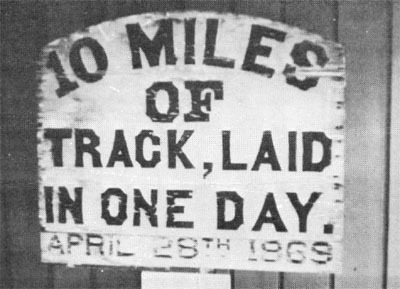Spike Centennial Commission, and president of the Association of American Railroads.
The principle speaker was John A. Volpe, U.S. Secretary of Transportation who praised the courage and determination of the original builders of the railroad.
The educational television station located at Brigham Young University recorded the whole proceedings on video tape, and spent two hours that evening showing a repeat performance. It is hoped that this will be available for showing in future years.
Back in 1965, 2,169 acres of ground and 15 miles of the old railroad bed were designated by Congress as a National Historic Site. A museum of wood and native stone was recently completed and dedicated earlier on the same day as the re-enactment ceremony.
The original rail line west from Corrine was abandoned in 1906, and the rails were ripped up and used for scrap in the war effort of 1942. However, much of the original roadbed is still visible from Corrine, and the National Park service has reconstructed 3,800 feet of line on the Summit, using the original roadbed.
Although all of the details of the original ceremony are not known, the 100th Anniversary reenactment was supposedly a faithful repition. The actors were from the Golden Spike Association of Box Elder County. They apparently researched the records carefully and attempted to repeat the original speeches as closely as possible. There was even a telegraph operator with an authentic piece of equipment sitting by to inform the rest of the nation when the last spike was driven. The actors faithfully repeated such details as the announcement that the president of the Union Pacific, T. C. Durant, had retired to his private car because of a "severe headache, " after which he returned to the ceremony and missed the spike by a mile.
The Golden Spike Association of Box Elder County has been in existence for a number of years, and consists of citizens from neighboring communities of Brigham City, Tremonton, and Corrine, For the previous seventeen years they have been going up to the site at Promontory Summit on May 10th, dressed in the authentic costumes, and reenacting the original ceremony. The ceremony on May 10, 1969, merely represented their eighteenth repeat performance. The guiding light of the group has been Bernice Gibbs Anderson, and her principle goal has been to preserve the original site, and to see that the 100th Anniversary celebration was held there instead of some other location. The group has also been active in having the site designated as a National Historic Site, and in persuading the National Park Service to construct a Museum facility.
After the ceremony the two locomotlves were supposed to come together as they did originally but since they were about 100 years old, and probably had rusty flues, they couldn't be fired up. The Park Service had originally intended to move them together with some sort of cable mechanism. However, this device was not operable, and so the motive power was furnished by a dozen or so husky park rangers behind each tender who pushed them together while the bells clanged loudly.
The engines themselves were painted in a bright red and black color, and has shiney brass trimmings. I suggested to one of the officials that the colors were a bit too gaudy, but I was assured that they had researched this carefully, and that the colors were truly authentic.
The track at the site was also authentic. The Union Pacific was building from the east and obtained its ties in the Wasatch mountains east of Ogden. They were cut and shaped with hand axes, and had pointed ends. They were mostly round with the bark still on and had a flat spot cut into the top for the rails to fit into. On the other hand, the Central Pacific, which was building from the west, obtained its ties in the Sierras, and these were cut and finished by machine, and were almost identical to present-day ties. This difference in ties is faithfully duplicated in the track relaid at the Summit. Across much of Utah and Nevada the original competing railroads had built about 200 miles of parallel roadbed, and this second roadbed has also been preserved some 100 feet south of the main line.
The museum itself is also interesting. It contains a small auditorium which shows a movie covering the original building of the railroad. It also has a fine exhibit showing the tools, equipment, and material used in laying the original track. Also on exhibit is one of the original signs which designated the site of "Ten Miles of Track Laid in One Day" which took place in the desert west of Promontory. This was accomplished by Central Pacific's Chinese coolies a few days prior to May 10, and still stands as the all-time record for putting down railroad track.

In my opinion the Musem is rather sterile, and not the usual sort of thing which would appeal to a genuine railroad fan. However, at the nearby town of Corrine, through which you must pass on the way to the site, there is an excellent railroad museum. Two old locomotives plus a number of cars are on display. There is also a fine exhibit of just about every kind of railroad equipment, particularly the type used, around the turn of the century.
So, if you're planning to get up into Utah in the near future, drop by Corrine and Promontory. You'll be able to see a couple of old-time locomotives and displays and actually stand on the site where the greatest single event in railway history took place. (DH)